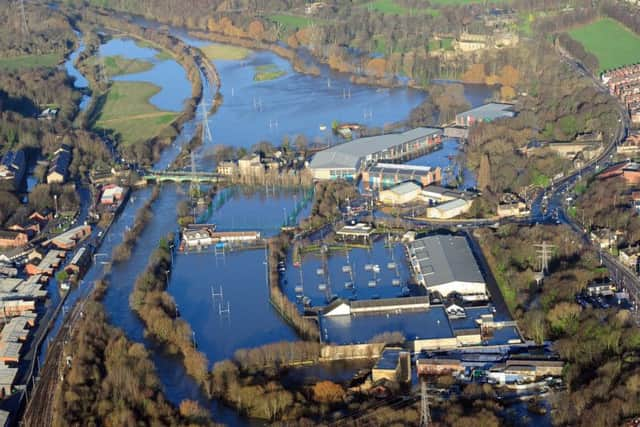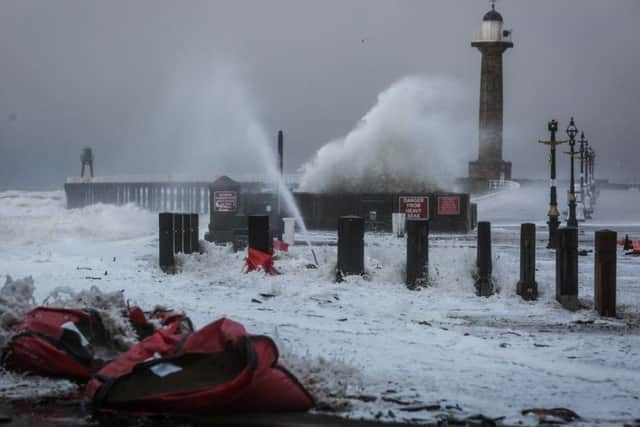Colin Mellors: How cash for coast is critical in fight against flooding
His plea coincided with the publication of the fourth UK Climate Projections. A mixture of compelling evidence and stark facts, the projections underline how changing weather patterns will affect us all, not least through increased flood risk, tidal surges and coastal erosion.
Although we can do more to address underlying causes of global warming, we need to plan for, and adapt to, a warming planet.
Advertisement
Hide AdAdvertisement
Hide AdNine of the 10 warmest years in the UK have occurred since 2002, whilst rainfall between November 2015 and January 2016 was the highest for the equivalent period since records began.


Three years ago this month, some Yorkshire communities were devastated by the Boxing Day floods. It is also the fifth anniversary of the 2013 Humber tidal surge.
For those directly affected, flooding is traumatic – physically, financially and emotionally. For every family flooded, many more will be impacted through businesses destroyed, jobs lost, schools closed and major interruptions to travel and key utilities.
Between 2015 and 2021, the Government is investing £2.6bn to mitigate flood risk, including £600m locally. Over 200 projects are taking place across Yorkshire, including major schemes in the Calder Valley, East Riding, Hull, Leeds, Sheffield and York. Some are large construction projects, whilst others, such as Pickering, are deploying nature to “slow the flow” to help protect downstream areas.
Advertisement
Hide AdAdvertisement
Hide AdAs well as reducing risks to residential properties, such schemes achieve wider benefits and represent productive investments that help protect businesses and infrastructure, support growth and open up land for new uses.


The Environment Agency (EA) has responsibility for co-ordinating flood risk management, but projects are often driven, and part-funded, by local authorities and supported by local communities. Despite their financial pressures and other priorities, councils work hard to address flood risk – invariably in a non-partisan way and, often, across administrative boundaries.
With 185km of coastal frontage in Yorkshire, some of the greatest challenges are those facing coastal communities where erosion rates are variable but can average over 2.5 metres annually.
Elsewhere, however, councils such as North Yorkshire, Scarborough, East Riding and Hull are contributing significant resources, alongside those from Government, the EA and other partners, to create a more resilient Yorkshire coast.
Advertisement
Hide AdAdvertisement
Hide AdIn Runswick Bay, an award-winning £2.9m scheme of seawall repairs and rock armour is helping protect the bay’s residents who have, themselves, contributed financially.
Sandsend’s innovative 1km revetment and slope stability scheme will help protect a key coastal road, generating £84m of economic benefit. Whitby’s iconic piers are being reinforced and additional funding from the York, North Yorkshire and East Riding LEP, and from the EU, is providing support to this important initiative.
One of the biggest coastal projects is now under way in Scarborough – a £15.9m scheme to help stabilise land above the Spa, protecting 380 homes and generating over £150m of economic impact.
The area further south includes some of the fastest- eroding coastline in Europe, with little feasible opportunity for active intervention. However, schemes such as Withernsea (£2.5m to replace seven dilapidated groynes) and Seathorne (£1.5m for a 150m long concrete revetment) will reduce risks.
Advertisement
Hide AdAdvertisement
Hide AdThe Humber estuary is the area most directly exposed to rising sea levels. With much of it on low-lying land, 230,000 homes, 50,000 businesses and 120,000 hectares of high-grade agricultural land are vulnerable to tidal flooding. The area is critically important for the production of a significant proportion of UK energy.
Several large schemes are taking place to strengthen resilience of Hull and Humber frontages including the pioneering glass seawall at Paull. Further ahead, a partnership comprising the EA, 12 local authorities and the Humber LEP is devising a comprehensive 100-year strategy to help protect this area.
Climate change brings tough choices. Whilst risks can be reduced, flooding can never be totally avoided. It means deciding what to protect and how. It means balancing resources between those that protect and those that assist – helping resilience and recovery when flooding does occur.
Above all, it needs us all to play a part – understanding issues and sharing responsibilities for delivering solutions so that, despite the challenges, communities continue to live, and thrive, alongside water.
Professor Colin Mellors is chair of Yorkshire Region Flood and Coastal Committee.